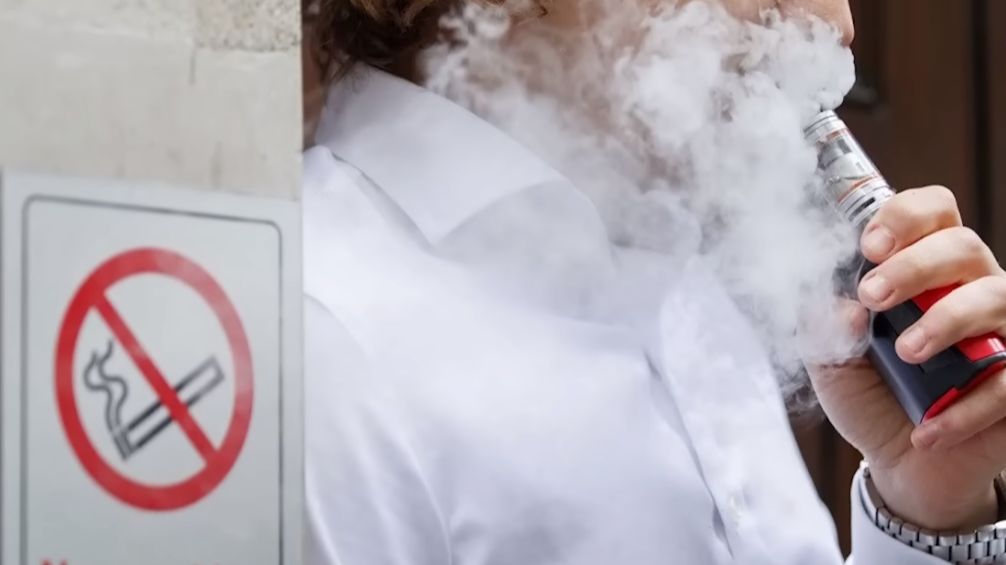On the evening of May 13, Prime Minister Pham Minh Chinh issued a directive requiring ministries and localities to implement various measures to enhance control and prevent the harmful effects of electronic cigarettes and heated tobacco products. The Prime Minister assessed that the smoking rate of traditional cigarettes has decreased by an average of 0.5% per year in men, but recently there has been a widespread emergence of electronic cigarettes and heated tobacco products. This new type has a tendency to increase rapidly, adversely affecting the health of users.
In response to this situation, the Prime Minister requested the Ministry of Health to enhance communication on the harmful effects of electronic cigarettes and heated tobacco products; conduct research and propose management solutions. The Ministry of Finance directed Customs to tightly control the transportation of electronic cigarettes through border gates, establish a task force to combat smuggling groups. In addition, there must be a strong emphasis on raising awareness of the harmful effects, as required by the Prime Minister, with the Ministry of Information and Communications, Education and Training, and media agencies.
So what are electronic cigarettes and why are they more harmful than traditional cigarettes?

Traditional cigarettes only need to be lit to smoke, but electronic cigarettes do not require that, they use electricity to heat the current substance. Electronic cigarettes are widely circulated in many countries around the world, including Vietnam. Especially among young people, there are many components in electronic cigarettes, including the main component nicotine, an addictive substance found in cigarettes. Typically, electronic cigarettes contain a lower amount of nicotine, ranging from 3 to 36 mg per ml compared to traditional cigarettes.
However, there are also types with high nicotine concentrations similar to traditional cigarettes. The vapor solution consists of propylene glycol and glycerin, which when heated, the water vaporizes and combines with the remaining substances to produce a smoke-like product for the smoker to feel like they are smoking. Although substances like propylene glycol and glycerin are approved by the FDA for use in the food, pharmaceutical, and cosmetic industries, when burned, they can produce harmful products for the body. The flavoring agents are chemicals that create different flavors such as fruits, chocolate, vanilla. Young people mistakenly believe that using electronic cigarettes will reduce the health impact compared to traditional cigarettes. However, many studies have shown that using electronic cigarettes has a significant impact on health.
Although electronic cigarettes have only been around for about 10 years, many studies have shown serious health effects, especially on the respiratory and cardiovascular systems. Therefore, using electronic cigarettes to quit traditional cigarettes is a mistake.
The harmful substances to the body produced by electronic cigarettes mostly come from the chemical products of the vapor and flavoring agents, the longer the exposure, the more impact on health. Therefore, those who are more exposed will be more affected, including active and passive smokers. Chemicals produced from the vapor and burning of flavoring agents can cause serious effects on the respiratory and cardiovascular systems. Long-term effects can cause cell toxicity and increase the risk of cancer. Electronic cigarettes produce vapor that users inhale by heating a liquid solution that usually contains nicotine, an addictive substance notorious in traditional cigarettes and other tobacco products.
Flavoring agents and other smoke-producing chemicals

People who do not smoke but stand near those who use electronic cigarettes may unfortunately inhale this gas when the smoker exhales into the air, making it difficult for consumers to know what they are inhaling. There have been cases where some brands of electronic cigarettes advertised as nicotine-free were found to contain this notorious addictive substance. Some metals such as lead, silver, chromium, nickel, formaldehyde have levels equivalent to or higher than traditional cigarettes. Therefore, electronic cigarettes are harmful to users and those around them. Fine particles in the air have the ability to penetrate deep into the lungs and may pose risks of rare diseases in regular smokers.
Biological markers of nicotine exposure have been found in non-smokers exposed to electronic cigarette vapor, indicating that the emissions from electronic cigarettes can pose risks to those around them. According to Dr. Nguyen Trung Nguyen, director of the poison control center at Bach Mai Hospital, the use of electronic cigarettes is rapidly spreading, especially among young people, and many cases of acute poisoning have occurred after using electronic cigarettes. From January 2022 to October 2023, the poison control center at Bach Mai Hospital received over 120,000 admissions after using electronic cigarettes. Notably, test results showed that 16,000 of the electronic cigarette samples brought in tested positive for drugs.
According to this expert, it is impossible to know if electronic cigarettes contain drugs when people deliberately mix addictive substances into the solution. Therefore, when smoking electronic cigarettes with drugs, patients often experience symptoms of stimulant shock, consciousness disorders, and even coma. The chemical composition of electronic cigarettes is much more complex than traditional cigarettes, causing many health hazards. Many people mistakenly believe that electronic cigarettes are safe. Dr. Nguyen Canh warns that using electronic cigarettes can cause serious acute and chronic diseases more dangerous than traditional cigarettes. Electronic cigarettes also have harmful effects not seen in traditional cigarettes, such as being related to acute lung injury, coronary artery disease.

Electronic cigarettes can cause unintended injuries.
Defective electronic cigarette batteries have caused explosions, some of which have led to serious injuries. Most explosions occur when electronic cigarette batteries are charging, and the data on this risk has been collected and evaluated by the FDA. In addition, acute nicotine exposure can have serious harmful effects. There have been cases of children and adults being poisoned by swallowing or inhaling the liquid in electronic cigarettes into their eyes or on their skin. Most electronic cigarettes contain nicotine, notorious for its addictive and toxic effects on developing fetuses exposed to nicotine can also have adverse effects on the developing brains of adolescents, a process that often lasts until 20-25 years old.
The vapor from electronic cigarettes contains harmful lung irritants, and another concern is that young people tend to use both electronic cigarettes and other products, including traditional cigarettes. Statistics on electronic cigarettes are very concerning. In the United States, young people have used electronic cigarettes more than adults, with the nicotine-containing electronic cigarette usage rates in 8th, 10th, and 12th grades increasing to 9%, 15%, and 16.5%, respectively, a historical increase in the world.
Vietnam is not lagging behind in this trend, with a 2.57% usage rate among students aged 13 to 17. Research from the Institute of Health Policy and Strategy in 2020 showed a particularly high usage rate of electronic cigarettes in major cities. For example, students in grades 8 to 12 in Hanoi have an 88.35% usage rate, with the main reason for smoking being to appear mature, sometimes to show off in front of the opposite sex, thinking it is cool. Students with incomplete awareness and knowledge are very prone to buying harmful substances that have long-term health effects.
Managing electronic cigarettes is not easy.
According to current surveys, about 40 countries ban electronic cigarettes, with 18 countries banning heated tobacco products. In the ASEAN region, five countries completely ban electronic cigarettes: Thailand, Singapore, Laos, Brunei, and Cambodia. For them, this product causes significant economic damage, with estimated profits from the electronic cigarette manufacturing and trading industry only around 7 billion USD per year. Globally, the World Health Organization believes that smoking causes over 1 trillion USD in economic losses each year in terms of productivity and healthcare costs. Electronic cigarettes are also a controversial issue in Vietnam.

Recently, the Ministry of Finance proposed a 50% import tax on electronic cigarettes and related products in the draft Decree on preferential import-export tax rates, while the Ministry of Health has repeatedly recommended not allowing production, circulation, or trial of new tobacco products. The Ministry of Public Security believes that there is currently no import policy for these items, so the export tax regulations are not appropriate, whether it is a management or prohibition law, it is also an economic issue. If managed, what mechanism should be used, what tax rate Vietnam will have to establish a system of laws and regulations for extensive inspections. This will certainly consume many resources and budgets, potentially adding a burden to the finances while the country still has many other issues to address.
Even more importantly, the inspection process must be more stringent to prevent corruption loopholes. Prohibition will increase the risk of smuggling illegal imports into Vietnam. For example, Hong Kong has passed a law banning the import, production, sale, distribution, and advertising of alternative tobacco products, including electronic cigarettes, heated tobacco products, and herbal cigarettes. In October 2021, Hong Kong Customs then carried out a special operation to combat smuggling, handling 46 cases involving the seizure of about 360,000 products with an estimated market value of 10 million Hong Kong dollars, equivalent to 1.3 million USD.
Resolutely preventing electronic cigarettes and heated tobacco products is correct. However, building an effective management mechanism, promoting the elimination of tobacco among adolescents, requires a lot of time and effort.
